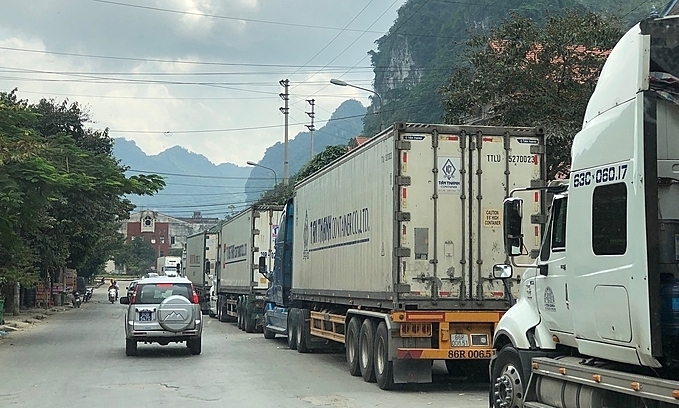Vietnam wants more northern border gates to process fruit exports to China
Fri, 25 Oct 2019 14:02:00 | Print | Email Share:

Vietnam will ask China to allow fruit shipments through additional gates as hundreds of containers pile up at the northern border, officials say.
The Ministry of Industry and Trade (MoIT) will negotiate with Chinese authorities to allow goods to pass through hitherto unused border gates in the northern province of Lang Son, like Chi Ma, Na Hinh and Binh Nghi, in order to resolve congestion at the Tan Thanh border gate, said Tran Thanh Hai, deputy director of the ministry’s Import and Export Department.
On Wednesday morning, in a meeting with Chinese Ambassador to Vietnam Xiong Bo and Yunnan Province’s Party Committee Deputy Secretary Wang Yobo, Deputy Prime Minister Vuong Dinh Hue had mentioned the difficulties Vietnamese exporters have been facing at the border, and asked China to help resolve the issue.
Xiong Bo said Chinese border authorities have been overwhelmed by the sudden surge in traffic, and have sent personnel to inspect and resolve the issue.
For his part, Wang Yobo said that the southern Chinese province wants to raise bilateral trade turnover with Vietnam, and stands ready to purchase Vietnamese farm produce in the near future.
As of Tuesday morning, around 400 container trucks, mostly carrying dragon fruit, were queued up at the Tan Thanh Border Gate, which specializes in exporting Vietnam's agricultural products to China.
The congestion has dragged for over a week, with over 250 fruit trucks showing up each day during the harvest season for dragon fruit. Before October 15, the gate received only around 100 trucks each day, said Nguyen Huu Vuong, deputy head of Lang Son Customs.
With hundreds of containers stuck over a week at the border and China tightening its import standards, exporters have expressed concern that the issue would crop up again in future harvest seasons for different fruits.
Vu Thi Nguyet, who owns an export company, said her firm has over 100 trucks lined up at the border, and it costs her VND30-50 million ($1,290-2,150) a day to rent a truck.
With the current situation, it is likely congestion will happen again in the upcoming watermelon harvest. "China now requires watermelons to be wrapped in foam, not straw. They must be packaged, and show stamps of origin and production information clearly on packaging," she said.
But without straw, Vietnamese enterprises cannot transport watermelon from the south to the northern border without crushing or damaging them. Once they reach the border gate, exporters will have to unpack and repackage the fruit in foam, costing much time and money, and they cannot find adequate warehousing facilities in the area, she added.
Her company had tried to export watermelon to China after the previous harvest, but the fruits were returned because they did not meet standards, Nguyet said.
'Easy market' no more
China is now applying stricter standards for imported fruits, extending the time it takes for each truck to pass through the border gate by 5-7 minutes. Now only 120-150 containers pass through Tan Thanh border gate each day, two or three times lower than earlier.
Nguyen Quoc Hai, deputy director of the Long Son Department of Industry and Trade, said exporters should be trying to meet whatever standards the Chinese market requires.
For their part, government agencies should also be directing businesses and merchants and keeping them updated on customs clearance requirements.
Le Hoang Oanh, director of MoIT’s Import and Export Department, had said at a conference in mid-September that exporters’ major misconceptions about China included the belief that it was an "easy market".
This mentality, along with the habit of exporting fruit through unofficial channels, meant they did not pay much attention to regulations or standards, and cultivation happened without exploring market demand. As a result, Vietnamese goods were currently unable to meet China’s new conditions, she said.
In the first eight months of this year, Vietnam exported $1.8 billion worth of fruits and vegetables to China, down 10.1 percent year-on-year, according to the Ministry of Agriculture and Rural Development.
China remained the biggest importer of Vietnamese fruits and vegetables in the eight-month period, accounting for 73.6 percent, but this was down from 74.9 percent the same period last year.
By: Anh Tu/Vnexpress
---------------------------------------------
Same category News :













